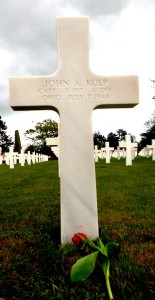These past days in Bayeux, France have been incredible. I have been able to experience life in a small, rural (ish) town with 18 of my good friends. I have been fortunate enough to have already seen some of the places we have visited during this program such as the American Cemetery at Normandy, Omaha Beach, and Mont St. Michael. It has been a few years, and I now have a much better understanding of the history and the significance of these sites. The two most poignant sites for me were the British and American cemeteries. It was fascinating comparing how these two countries chose to honor their fallen soldiers.
The first cemetery we stopped at was the American Cemetery. While wandering the museum, I ran into some great people. I was decked out in my Ohio State gear and a couple came up to me and told be that they had attended OSU as well. It still shocks me that no matter where I go, even halfway around the world, I can find people that love OSU as much as I do. Next I saw two men that looked like veterans. I was hesitant to go up to them and ask if they had served, because I know it is a sensitive issue for many vets, but I decided to risk it anyways. My risk paid off. The two men had fought on Sword beach and were meeting up again for the first time in 70 years! I was not able to talk to them long, they were in a rush, but I did get to thank them for their service and one of their wives offered to take a photo of me with them, so I will always have that keepsake.
There were some striking differences between the British and American cemeteries. The features that stood out the most for me were the headstones. In the American cemetery, all the headstones were white crosses, except for a few that had the Star of David on them instead. All the headstones in the British cemetery were practically the same shape. Some headstones were slightly different if the person buried was a German or Polish soldier or held a position that wasn’t in the British military. However, each headstone was individualized in the British cemetery. Every British soldier had their name, age, the symbol of the branch/regiment they served in, and a quote. Every grave in the American cemetery had the person’s name, rank, division, the state they were from, and the date that they died. Every grave looked practically the same in the American cemetery. It made it harder for me to realize that these were all individuals that lived extremely varied lives. I felt more removed from the fallen; I could distance myself from them. Quite the opposite happened to me in the British cemetery. I really could get the sense that each of these soldiers had their own unique lives and stories in the British cemetery, because every headstone was different. The quotes from some of the parents on the tombs made me tear up.
The American cemetery was a much more sterile place where the individual soldier was not highlighted. I’m not saying that America’s cemetery was not a humbling place, because it most definitely was, but the British cemetery created a much different atmosphere that I liked more. The British cemetery focused more on each soldier’s life rather than just their death. I feel like people could celebrate their lost loved one’s life –laugh, smile, and share stories about the past-while any sort of laughing would be frowned upon at the American cemetery. After comparing both these sites, I am now very interested in how and why the cemeteries were designed the way they were. I have also become more fascinated in how memorials are created and how people decide to commemorate the hurt, the sick, the brave, the dead, etc.


